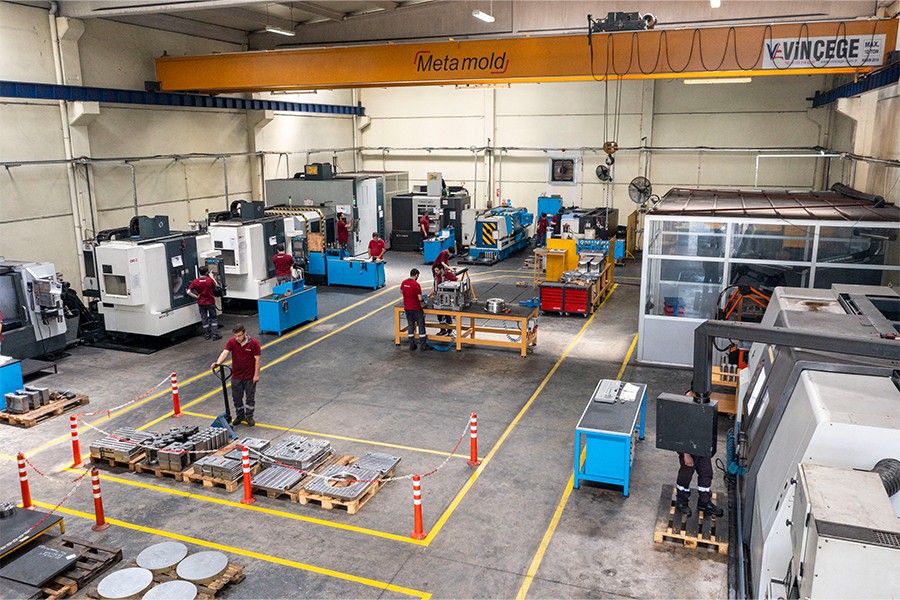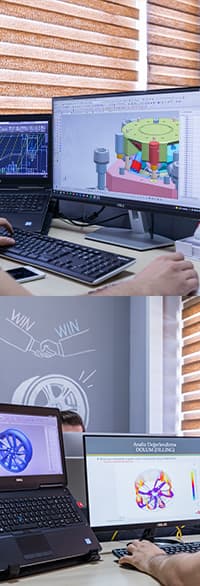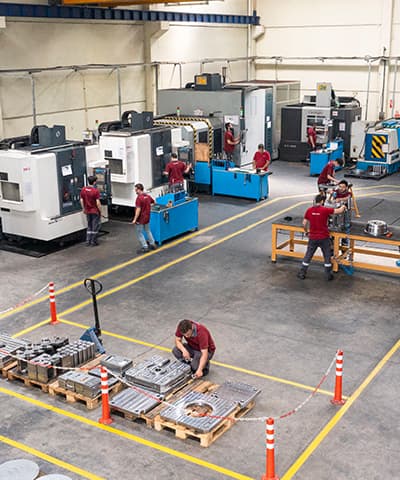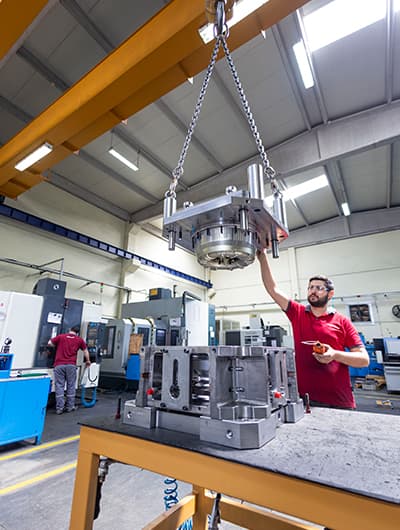- +90 236 233 20 03
- info@metamold.com
- Customer Portal

At Metamold, we prioritize high technology and quality in the production of Low Pressure Die Casting (LPDC) molds. With our engineering solutions that exceed industrial standards, we provide tailored solutions for the automotive, aerospace, defense, and many other sectors. We achieve excellent casting results through the use of high-quality materials, precise design methods, and the expertise of our specialized team. Each LPDC mold is meticulously produced in our state-of-the-art factories, offering durability, efficiency, and longevity. Our certified manufacturing processes and detailed quality control stages guarantee the reliability of our LPDC molds, making them the preferred choice for manufacturers seeking high performance and flawless results.
Low Pressure Die Casting (LPDC) refers to molds produced by injecting liquid metal alloys into molds under low pressure. It is typically used for aluminum, magnesium, and other lightweight metal alloys.
Features of LPDC Molds:
Applications of LPDC Molds:
LPDC mold prices vary according to project-specific requirements. It is important to consult with Metamold to obtain the most accurate price and request detailed information.
Average Price Ranges:
The design of Low Pressure Die Casting (LPDC) molds is a critical step for injecting metal alloys and allows for cost reduction while producing high-quality parts. LPDC mold design determines the success of the manufacturing process. A good design enhances the quality of the parts while reducing costs; thus, expertise and experience are crucial.

LPDC mold manufacturing is a complex process that requires technical knowledge and experience. Molds designed and selected with the right materials enable the production of high-quality and durable casting parts, reduce costs, and enhance production efficiency.
The Low Pressure Die Casting (LPDC) method offers numerous advantages in the production of metal parts, enhancing efficiency and improving product quality. LPDC molds enable the production of thin-walled and complex geometries, resulting in higher surface quality and fewer internal structure defects. The low pressure used (typically 0.5 to 1 bar) facilitates the flow of metal into the mold, reducing the formation of air bubbles. This method allows for the production of more parts with less material, thereby reducing processing requirements and costs. Additionally, the faster casting process shortens production times. LPDC can be used with aluminum, magnesium, and other lightweight metal alloys, providing flexibility across various industries. This environmentally friendly method generates less waste and consumes less energy. LPDC molds made with high-quality materials have wear resistance and extended lifetimes. The control of the cooling process due to low heat transfer minimizes the risk of deformation. Furthermore, it enables the production of complex shapes and details, increasing design freedom. The reduction of post-casting processing requirements further decreases costs and timelines. For these reasons, LPDC molds are preferred in many industries, offering high quality, cost-effectiveness, and production efficiency while enhancing their significance in modern manufacturing processes and providing a wide range of applications.


The maintenance and repair of Low Pressure Die Casting (LPDC) molds are crucial for production efficiency, cost reduction, and improved product quality. Regular cleaning of the molds removes metal residues and other contaminants from the surfaces. Acidic or alkaline solutions should be used for cleaning, and surface oils and grease residues should be removed with mechanical brushes or pressure water. Molds should be visually inspected after each use for signs of wear, cracks, or deformation, particularly paying attention to clogs in the cooling channels. The moving parts of the mold should be regularly lubricated to reduce friction, using suitable lubricants.
Repair processes include wear repair, crack repair, and replacement of mold parts. Wear can be addressed using welding or coating methods, while cracks should be repaired using appropriate heating and cooling processes. When mold parts wear out, spare parts should be sourced from manufacturing companies or reliable suppliers.
To extend the mold's lifespan, regular maintenance plans should be established, and operators and engineers should be trained in maintenance and repair. Additionally, quality control measures should be taken in mold production and usage processes. All these maintenance and repair processes extend the life of LPDC molds and reduce costs, serving as the key to a successful production process.
What is LPDC Mold?
LPDC (Low Pressure Die Casting) mold refers to molds produced by injecting metal alloys into molds under low pressure. It is typically used for casting lightweight metal alloys such as aluminum and magnesium.
What are the Advantages of LPDC Molds?
High product quality and low internal structure defects. Production of thin-walled and complex geometries. Low cost and fast production times. Obtaining lightweight and durable parts. Environmentally friendly production process.
In Which Industries are LPDC Molds Used?
LPDC molds are used in many industries, including automotive, aerospace, electronics, home appliances, construction, defense, and energy. They are particularly preferred where lightweight and durable parts are needed.
How Does the Production Process with LPDC Molds Work?
The production process starts with the design phase. The mold is designed using CAD software, then processed with CNC machines. The metal alloy is melted, injected into the mold under low pressure, and after the cooling process, removed from the mold. Finally, the parts undergo quality control processes.
How Durable are LPDC Molds?
LPDC molds are durable because they are produced using high-quality materials. The lifespan of the molds depends on the material quality, design, and usage conditions. Regular maintenance and repair can extend the lifespan of the molds.
How is the Quality of Parts Produced with LPDC Molds Ensured?
High-quality parts are ensured through proper design, quality material selection, effective cooling systems, careful management of the casting process, and regular quality control. Each stage must be carefully managed to enhance production quality.
How is the Maintenance of LPDC Molds Done?
Mold maintenance includes regular cleaning, visual inspection, lubrication, and repair processes. Molds should be cleaned of metal residues and contaminants, moving parts should be lubricated, and repairs should be made if wear or cracks are present.
What Materials are Used to Make LPDC Molds?
LPDC molds are typically made from high-quality steel, cast iron, aluminum, and other metal alloys. The choice of material significantly affects the durability and performance of the mold.
What is the Production Cost of LPDC Molds?
LPDC mold costs vary depending on design, size, material quality, and production quantity. Simple molds can start from a few thousand dollars, while complex and custom designs can go up to tens of thousands of dollars.
What are the Differences Between LPDC and HPDC Molds?
LPDC (Low Pressure Die Casting) typically operates at lower pressure, while HPDC (High Pressure Die Casting) uses higher pressure. LPDC provides higher surface quality and fewer internal structure defects, while HPDC is ideal for faster casting processes and high production volumes.